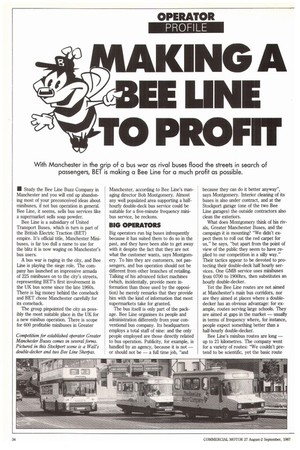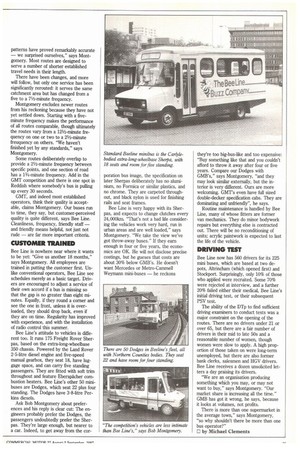KING A SEE LINE TO PROFIT
Page 36

Page 37

If you've noticed an error in this article please click here to report it so we can fix it.
With Manchester in the grip of a bus war as rival buses flood the streets in search of passengers, BET is making a Bee Line for a much profit as possible.
IN Study the Bee Line Buzz Company in Manchester and you will end up abandoning most of your preconceived ideas about minibuses, if not bus operation in general. Bee Line, it seems, sells bus services like a supermarket sells soap powder.
Bee Line is a subsidiary of United Transport Buses, which in turn is part of the British Electric Traction (BET) empire. It's official title, Manchester Minibuses, is far too dull a name to use for the blitz it is now waging on Manchester's bus users.
A bus war is raging in the city, and Bee Line is playing the siege role. The company has launched an impressive armada of 225 minibuses on to the city's streets, representing BET's first involvement in the UK bus scene since the late 1960s. There is big money behind the comeback and BET chose Manchester carefully for its comeback.
The group pinpointed the city as possibly the most suitable place in the UK for a new minibus operation. There is scope for 600 profitable minibuses in Greater Manchester, according to Bee Line's managing director Bob Montgomery. Almost any well populated area supporting a halfhourly double-deck bus service could be suitable for a five-minute frequency minibus service, he reckons.
BIG OPERATORS
Big operators run big buses infrequently because it has suited them to do so in the past, and they have been able to get away with it despite the fact that they are not what the customer wants, says Montgomery. To him they are customers, not passengers, and bus operation should not be different from other branches of retailing. Talking of his advanced ticket machines (which, incidentally, provide more information than those used by the opposition) he merely remarks that they provide him with the kind of information that most supermarkets take for granted.
The bus itself is only part of the package. Bee Line organises its people and administration differently from your conventional bus company. Its headquarters employs a total staff of nine: and the only people employed are those directly related to bus operation. Publicity, for example, is handled by an agency, because it is not — or should not be — a full time job, "and because they can do it better anyway", says Montgomery. Interior cleaning of its buses is also under contract, and at the Stockport garage (one of the two Bee Line garages) the outside contractors also clean the exteriors.
What does Montgomery think of his rivals, Greater Manchester Buses, and the campaign it is mounting? "We didn't expect them to roll out the red carpet for us," he says, "but apart from the point of view of the public they seem to have replied to our competition in a silly way." Their tactics appear to be devoted to protecting their double-deck half hourly services. One GMB service uses minibuses from 0700 to 1900hrs, then substitutes an hourly double-decker.
Yet the Bee Line routes are not aimed at Manchester's main bus corridors, nor are they aimed at places where a doubledecker has an obvious advantage: for example, routes serving large schools. They are aimed at gaps in the market — usually in terms of frequency where, for instance, people expect something better than a half-hourly double-decker.
Bee Line's minibus routes are long — up to 21 kilometres. The company went for a variety of routes: "We couldn't pretend to be scientific, yet the basic route patterns have proved remarkably accurate — we surprised ourselves," says Montgomery. Most routes are designed to serve a number of shorter established travel needs in their length.
There have been changes, and more will follow, but only one service has been significantly rerouted: it serves the same catchment area but has changed from a five to a 71/2-minute frequency.
Montgomery excludes newer routes from his reckoning because they have not yet settled down. Starling with a fiveminute frequency makes the performance of all routes comparable, though ultimately the routes vary from a 121/2-minute frequency on one or two to a 21/2-minute freuquency on others. "We haven't finished yet by any standards," says Montgomery.
Some routes deliberately overlap to provide a 21/2-minute frequency between specific points, and one section of road has a 13/4-minute frequency. Add in the GMT competition and there is one spot in Reddish where somebody's bus is pulling up every 30 seconds.
GMT, and indeed most established operators, think their quality is acceptable, claims Montgomery. Our buses run to time, they say, but customer-perceived quality is quite different, says Bee Line. Cleanliness, frequency, friendly staff — and friendly means helpful, not just not rude — are far more important criteria.
CUSTOMER TRAINED
Bee Line is nowhere near where it wants to be yet: "Give us another 18 months," says Montgomery. All employees are trained in putting the customer first. Unlike conventional operators, Bee Line see schedules merely as a basic target. Drivers are encouraged to adjust a service of their own accord if a bus is missing so that the gap is no greater than eight minutes. Equally, if they round a corner and see the one in front, unless it is overloaded, they should drop back, even if they are on time. Regularity has improved with experience, and with the installation of radio control this summer.
Bee Line's attitude to vehicles is different too. It runs 175 Freight Rover Sherpas, based on the extra-long-wheelbase 350 chassis. Powered by the Land Rover 2.5-litre diesel engine and five-speed manual gearbox, they seat 18, have luggage space, and can carry five standing passengers. They are fitted with soft trim throughout and feature Eberspacher combustion heaters. Bee Line's other 50 minibuses are Dodges, which seat 22 plus four standing. The Dodges have 3-8-litre Perkins diesels.
Ask Bob Montgomery about preferences and his reply is clear cut: The engineers probably prefer the Dodges, the passengers undoubtedly prefer the Sherpas. They're large enough, but nearer to a car. Indeed, to get away from the cor poration bus image, the specification on later Sherpas deliberately has no aluminium, no Formica or similar plastics, and no chrome. They are carpeted throughout, and black nylon is used for finishing rails and seat frames.
Bee Line is very happy with its Sherpas, and expects to change clutches every 24,000km. "That's not a bad life considering the vehicles work very hard, run in urban areas and are well loaded," says Montgomery. "We take the view we've got throw-away buses." If they earn enough in four or five years, the economics are OK. He will not disclose precise costings, but he gueses that costs are about 30% below GMB's. He doesn't want Mercedes or Metro-Carmel] Weymann mini-buses — he reckons they're too big-bus-like and too expensive: "Buy something like that and you couldn't afford to throw it away after four or five years. Compare our Dodges with GMB's," says Montgomery, "and they may look similar externally, but the interior is very different. Ours are more welcoming. GMT's even have full sized double-decker specification cabs. They are dominating and unfriendly", he says.
Routine maintenance is handled by Bee Line, many of whose fitters are former van mechanics. They do minor bodywork repairs but everything else is contracted out. There will be no reconditioning of units; acrylic paintwork is expected to last the life of the vehicle.
DRIVING TEST
Bee Line now has 560 drivers for its 225 mini buses, which are based at two depots, Altrincham (which opened first) and Stockport. Surprisingly, only 10% of those who applied were recruited. Some 70% were rejected at interview, and a further 20% failed either their medical, Bee Line's initial driving test, or their subsequent PSV test.
The ability of the DTp to find sufficient driving examiners to conduct tests was a major constraint on the opening of the routes. There are no drivers under 21 or over 65, but there are a fair number of drivers in their mid to late 50s and a reasonable number of women, though women were slow to apply. A high proportion of those taken on were long-term unemployed, but there are also former bank clerks, salesmen and HGV drivers. Bee Line receives a dozen unsolicited letters a day praising its drivers.
"We are an organisation producing something which you may, or may not want to buy," says Montgomery. "Our market share is increasing all the time." GMB has got it wrong, he says, because it looks at volumes, not profits.
There is more than one supermarket in the average town," says Montgomery, "so why shouldn't there be more than one bus operator?"
El by Michael Clements








































































































